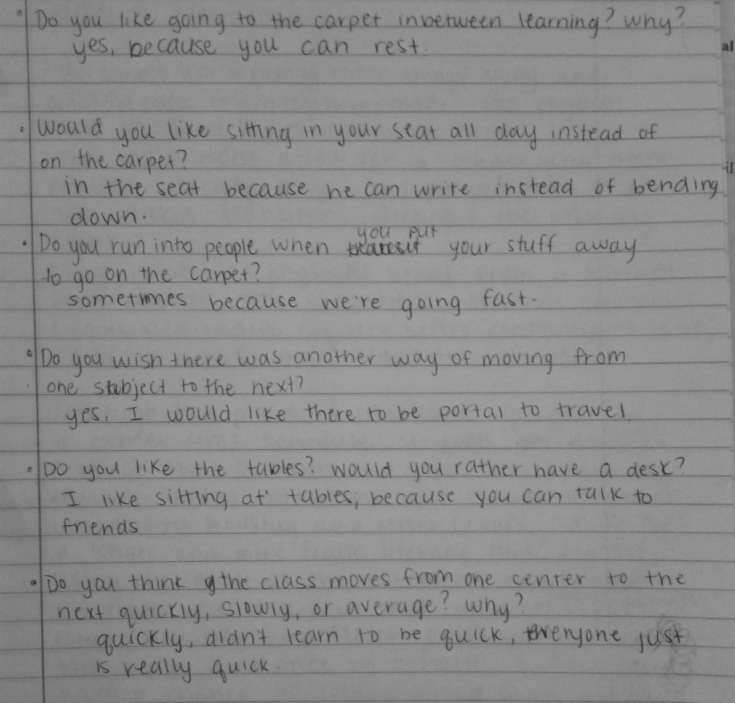As I study the transition management system within my CT’s classroom, I have been collecting data in various different ways to see how influential the rug transition and having tables are on the time to transition from one activity to the next. Last week, I was able to collect data through a video and the observational notes of my supervisor. Although these gave me a good insight into my inquiry, I decided that I wanted to include my students’ perspective as well. I thought, what better way to understand the carpet transition then to ask the students who are doing it? The questions that I asked my student were phrased in a format that a kindergartener would be able to respond to. I didn’t want to over question and confuse my student, otherwise I wouldn’t really get their true thoughts because they wouldn’t know what I was asking. I included in image of the the interview below:

Although there were a few answers that strayed from the question I was asking, I think the key answer that really sparked an interest for me was the first response: “because you can rest”. This response got me thinking, “is there research that shows movement from one location to another benefits learning?” This piece of data actually guided me into my next data collection because I wanted to learn more about this question.
From a prior course, I remember that the book The Daily 5 did a lot of research on how the brain worked and why they designed their center structure the way they did. I figured since I already had the resource, I would look back into it and see if there was anything about this movement/rest idea. After going through and skimming the text book, I found a section that talked specifically about their transitions with their center time. Although this piece of literature focused on a center time schedule, it did provide me with a great information that supported and explained my students response. Having transitions that include movement according to Boushey and Moser (2014), “allow for a longer and more focused literacy time” (p. 33). Using the carpet as the movement opportunity provides students with that physical and kinesthetic break that Boushey and Moser (2014) suggest gives the brain a chance to refocus–i.e. a time to “rest”. Letting students have a chance to refocus with a break allows students to regain their attention span that will allow for more authentic academic learning time. Additionally they also say that “the simple act of putting their things away and walking back to join together provides the physical break children’s bodies and minds need” (p. 32) This quote made me think about the age of the students that I have in my class. I have to remember that these students are only five or six years old, for them to sit in one spot all day long is not developmentally appropriate. I think that this week’s data collection gave me a great new perspective that I could test through looking at the difference in the students’ engagement after movement to the carpet verses no movement to the carpet. I can also test to see how the length of the break affects the smoothness and engagement level into the next activity. Another thing I could test from learning about this movement/rest theory is the difference in the carpet transition verses a different movement transition that doesn’t require the carpet. Does having the ability to “join together” as Boushey and Moser describe make a difference? There are a lot of next steps that I can take as I continue on this inquiry journey next week.
Reference:
Boushey, G., & Moser, J. (2014). The daily 5: Fostering literacy independence in the elementary grades (2nd ed.). Portland, ME: Stenhouse Publishers.
Leave a comment